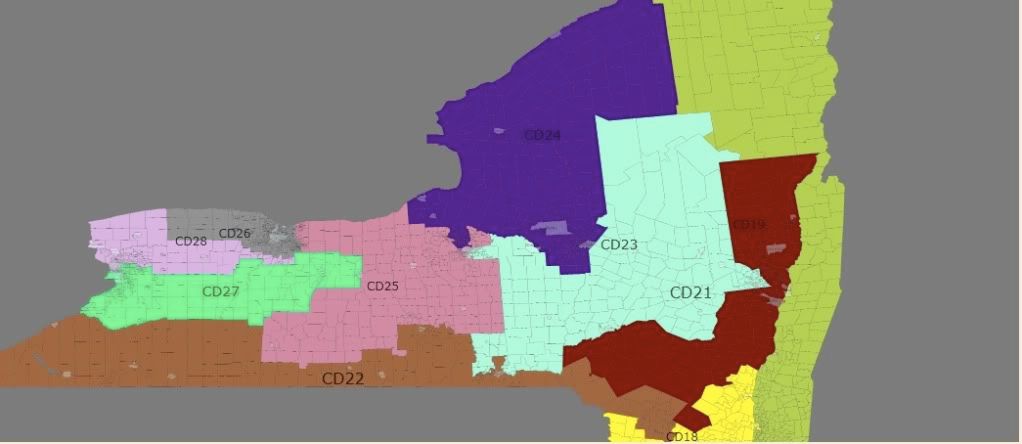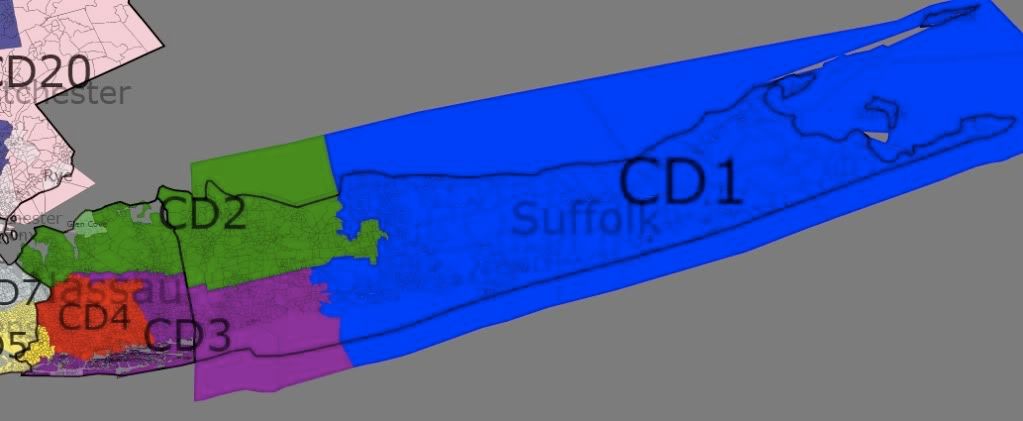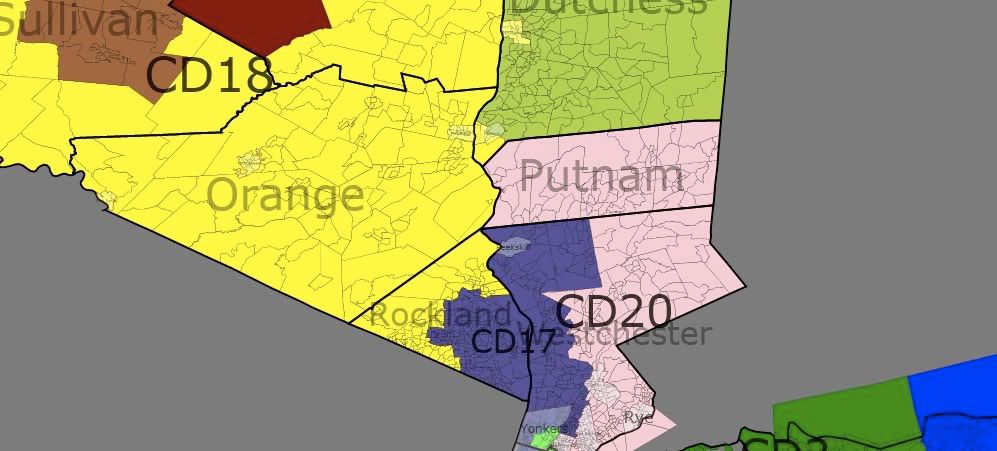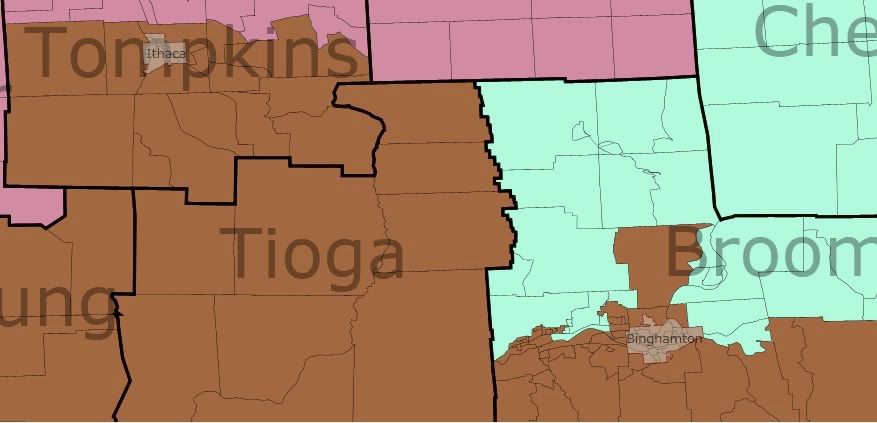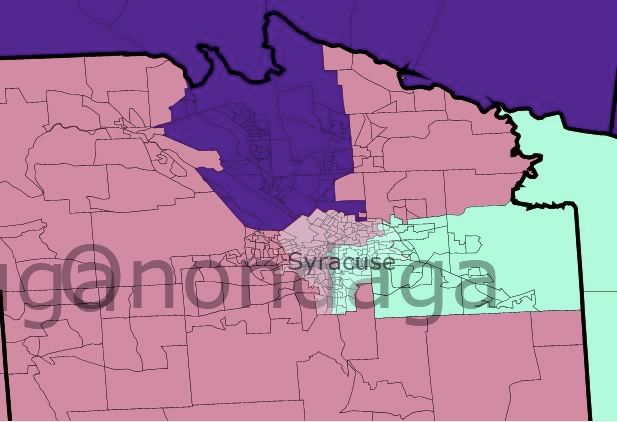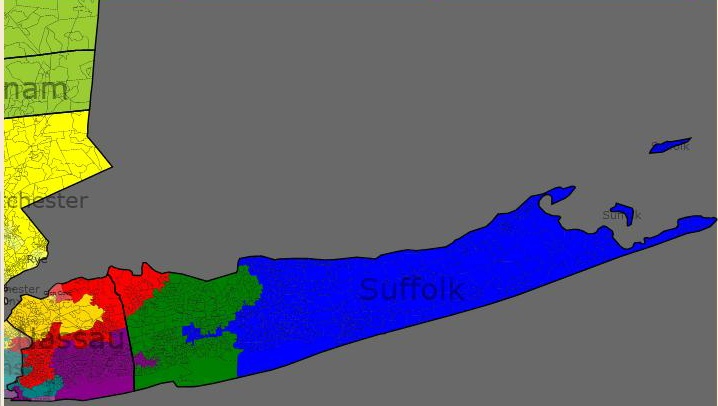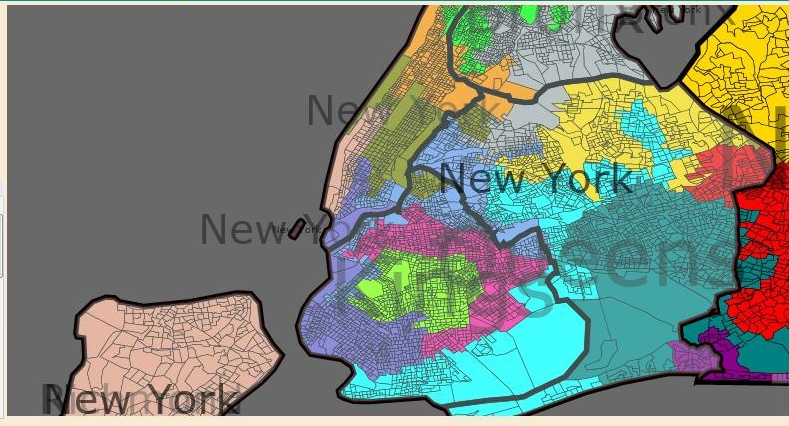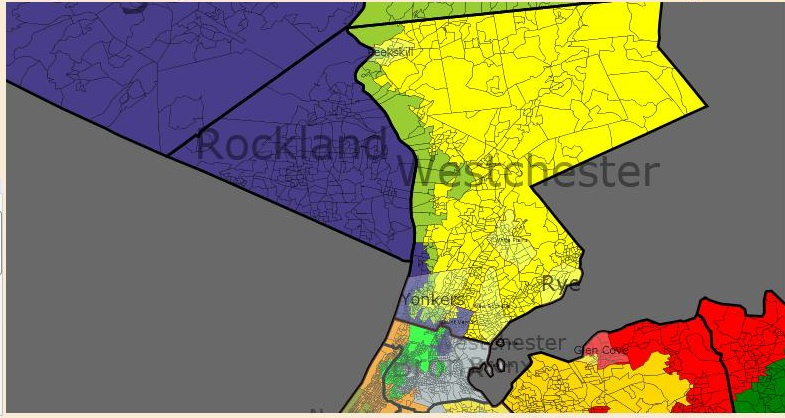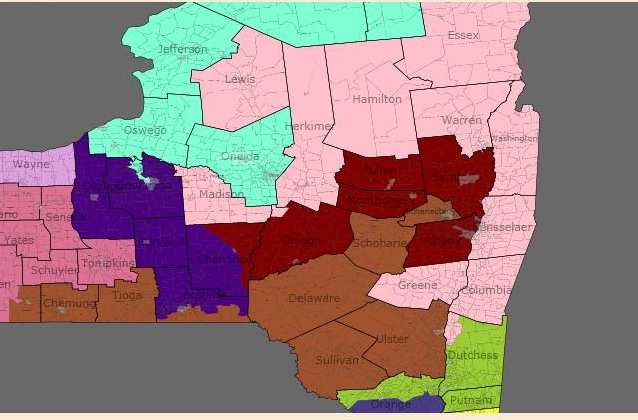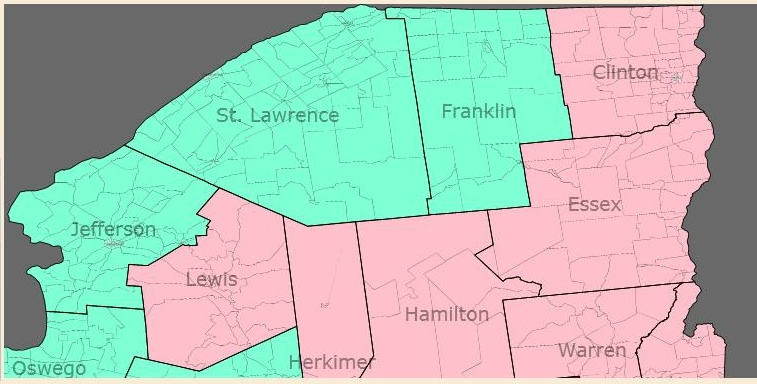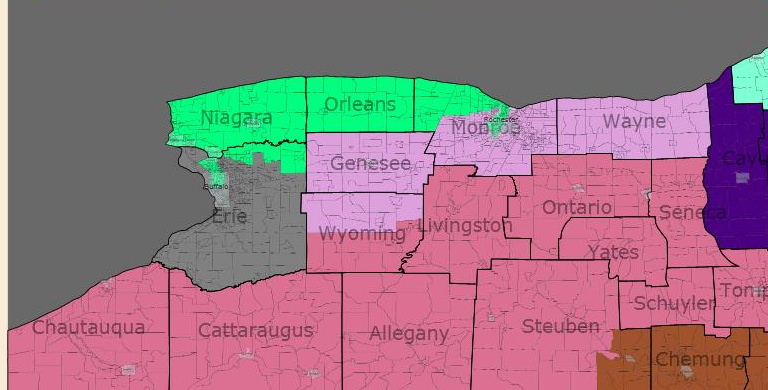(From the diaries – promoted by DavidNYC)
This redistricting map has really been a long time coming, but trying to match up the 36,000 census blocks of NYC and the 20,000 blocks of Nassau County (among many, many others) with a precinct and creating a consolidated population-political data file tends to take a while. But unquestionably, I also think this is my best map yet. I used 2008 population estimates by city/town, projected forward to 2010. I also worked painstakingly hard for population equality, which I think is evident in that the total deviation for all 28 districts is 86, or 0.012% of a single district.
At a whopping 26-3, our NY delegation is already pretty maxed out. With the loss of a district in 2010, there’s a good opportunity to consolidate and create what could possibly be a 27-1 delegation. I chose to do this by eliminating John McHugh’s district and then employing some old-fashioned cracking of Nassau County to defeat Peter King. Side goals included strengthening Massa, Arcuri, Murphy, Hall, and McMahon, while preserving VRA districts for Meeks, Towns, Clarke, Velazquez, Rangel, and Serrano.
My district maps later. First, some eye candy:
I’m sure there’s enough in these maps to make for its own diary, but that’s for another time….
(Sidenote: Yes, I am sending my dataset to Dave and David, so hopefully this can be incorporated into DRA. I do have a ‘tutorial’ on how I do my redistricting where I used Wisconsin as an example that I will hopefully post shortly.)
Now, here’s my map:
Starting upstate:
| County/Division |
2010 Pop |
Obama |
McCain |
Obama% |
McCain% |
Black% |
Hisp% |
Asian% |
| 28 |
700,339 |
201,234 |
133,976 |
59.32% |
39.50% |
13.23% |
5.28% |
2.54% |
| Livingston |
16,497 |
4,721 |
3,483 |
56.67% |
41.81% |
1.38% |
1.87% |
1.87% |
| Monroe |
683,842 |
196,513 |
130,493 |
59.39% |
39.44% |
13.52% |
5.36% |
2.55% |
As is the case with a lot of my districts, I took some inspiration from the districts of yesteryear (or… 1993-2003). This would still be Louise Slaughter’s district, recentered around Monroe County (with an arm to grab Geneseo out of Livingston County). The percentage drop seems daunting at first (down from 68.47%), and there’s not a good reason for Buffalo and Rochester to be packed into the same district. Anyways, Slaughter is familiar with the area and would be solid for any Rochester Democrat should Slaughter choose to retire.
| County/Division |
2010 Pop |
Obama |
McCain |
Obama% |
McCain% |
Black% |
Hisp% |
Asian% |
| 27 |
700,326 |
184,327 |
130,941 |
57.52% |
40.86% |
10.02% |
3.79% |
1.66% |
| Erie |
429,193 |
127,515 |
72,116 |
62.87% |
35.56% |
12.69% |
5.06% |
2.36% |
| Monroe |
15,048 |
2,895 |
2,769 |
50.22% |
48.03% |
3.39% |
2.85% |
1.06% |
| Niagara |
214,319 |
47,303 |
46,348 |
49.65% |
48.65% |
5.78% |
1.29% |
0.57% |
| Orleans |
41,766 |
6,614 |
9,708 |
39.87% |
58.53% |
6.82% |
3.88% |
0.32% |
I think a lot of times, we overestimate the Democratic strength of Brian Higgins’ district – he was only elected in 2004, and Obama only scored 54.19% here. I’ll admit, I shuffled around this district quite a bit, with it going from Buffalo north instead of south. We add all of Niagara and Orleans Counties, with a sliver of Monroe for population balancing, but we do retain all of Buffalo’s South District, which Higgins represented in the Buffalo Common Council before getting elected to Congress. From this we get slightly more than a 3% boost to 57.52%; this should be safe for a long time to come.
| County/Division |
2010 Pop |
Obama |
McCain |
Obama% |
McCain% |
Black% |
Hisp% |
Asian% |
| 26 |
700,339 |
171,771 |
144,151 |
53.52% |
44.91% |
9.24% |
2.02% |
0.64% |
| Allegany |
34,270 |
5,028 |
7,071 |
40.66% |
57.18% |
0.95% |
0.93% |
0.86% |
| Cattaraugus |
65,144 |
12,365 |
14,715 |
44.91% |
53.44% |
1.15% |
0.98% |
0.52% |
| Chautauqua |
133,249 |
29,129 |
28,579 |
49.54% |
48.60% |
2.00% |
4.12% |
0.35% |
| Chemung |
55,777 |
12,400 |
10,904 |
52.67% |
46.31% |
8.20% |
2.35% |
0.65% |
| Erie |
373,522 |
105,070 |
73,706 |
57.88% |
40.60% |
14.92% |
1.62% |
0.64% |
| Steuben |
38,377 |
7,779 |
9,176 |
45.29% |
53.42% |
1.71% |
0.83% |
1.59% |
Granted, I shifted around Massa’s district quite a bit too, with it now going to Buffalo instead of Rochester. I did this in the interest of centering the 28th in Monroe County and leaving room for the sprawling 23rd. However, I think it retains its Southern Tier character (roughly 40%). The nastier bits of Steuben and Allegany counties are carved out. The Democratic boost from the remaining parts of Buffalo doesn’t hurt either, leaving this district 5 points better at 53.52%.
| County/Division |
2010 Pop |
Obama |
McCain |
Obama% |
McCain% |
Black% |
Hisp% |
Asian% |
| 25 |
700,324 |
181,879 |
137,622 |
55.94% |
42.33% |
6.42% |
2.23% |
1.51% |
| Cayuga |
52,661 |
11,864 |
9,433 |
54.62% |
43.43% |
4.07% |
1.79% |
0.43% |
| Monroe |
7,352 |
2,159 |
2,440 |
46.39% |
52.43% |
1.26% |
1.06% |
1.93% |
| Onondaga |
427,685 |
122,984 |
78,566 |
59.93% |
38.29% |
9.11% |
2.44% |
2.12% |
| Ontario |
39,862 |
9,316 |
10,334 |
46.78% |
51.89% |
0.70% |
1.33% |
0.73% |
| Oswego |
71,434 |
15,429 |
12,598 |
53.90% |
44.01% |
0.78% |
1.77% |
0.55% |
| Seneca |
9,816 |
1,943 |
2,012 |
48.32% |
50.04% |
0.83% |
1.72% |
0.35% |
| Wayne |
91,514 |
18,184 |
22,239 |
44.37% |
54.27% |
3.08% |
2.37% |
0.47% |
This district doesn’t substantially differ from Maffei’s current version, though I do take out a chunk of southern Onondaga county to make room for the 24th to pass through. Since we’re dismantling the current 23rd, the section of Oswego County begins to pick up some of the pieces. Still centered on Syracuse and DeWitt, this district has a marginal improvement of 0.2%, leaving it still a touch short of 56% Obama.
| County/Division |
2010 Pop |
Obama |
McCain |
Obama% |
McCain% |
Black% |
Hisp% |
Asian% |
| 24 |
700,337 |
156,841 |
139,301 |
52.08% |
46.25% |
2.99% |
2.25% |
1.68% |
| Cayuga |
26,714 |
6,264 |
5,810 |
50.92% |
47.23% |
2.97% |
2.09% |
0.43% |
| Cortland |
36,312 |
9,545 |
6,707 |
57.75% |
40.58% |
0.94% |
1.30% |
0.50% |
| Herkimer |
38,842 |
8,096 |
8,639 |
47.56% |
50.75% |
0.57% |
1.07% |
0.46% |
| Jefferson |
70,332 |
12,923 |
14,011 |
47.32% |
51.30% |
3.67% |
2.89% |
0.66% |
| Livingston |
12,089 |
2,473 |
3,589 |
40.15% |
58.27% |
0.63% |
0.98% |
0.37% |
| Madison |
50,197 |
10,990 |
10,961 |
48.96% |
48.83% |
0.55% |
0.82% |
0.32% |
| Oneida |
167,933 |
33,209 |
33,409 |
49.08% |
49.37% |
6.05% |
3.34% |
1.40% |
| Onondaga |
24,405 |
6,333 |
6,406 |
48.72% |
49.28% |
0.93% |
0.77% |
0.55% |
| Ontario |
65,884 |
15,787 |
14,837 |
50.78% |
47.73% |
2.47% |
2.52% |
0.65% |
| Oswego |
49,797 |
9,348 |
10,973 |
45.11% |
52.95% |
0.27% |
0.62% |
0.22% |
| Schuyler |
6,613 |
1,678 |
1,737 |
48.50% |
50.20% |
0.60% |
0.77% |
0.26% |
| Seneca |
24,097 |
5,479 |
5,026 |
51.11% |
46.88% |
3.44% |
2.26% |
0.81% |
| Tompkins |
102,388 |
29,826 |
11,927 |
70.23% |
28.08% |
3.39% |
3.06% |
7.15% |
| Yates |
24,734 |
4,890 |
5,269 |
47.57% |
51.25% |
0.53% |
0.92% |
0.27% |
Tompkins County saved Arcuri from defeat in 2008, and this district helps on that front. It now incorporates all of Tompkins. Arcuri’s base in Utica remains as well, though the rest of Oneida County is surprisingly hostile to Democrats. Eastern Oswego and western Jefferson Counties are added, again to compensate for the elimination of the current 23rd. Overall, this district improves modestly to 52.08% from 50.33%. Obama only narrowly lost the district outside of Tompkins, but Ithaca is really what anchors the district.
| County/Division |
2010 Pop |
Obama |
McCain |
Obama% |
McCain% |
Black% |
Hisp% |
Asian% |
| 23 |
700,324 |
131,014 |
186,390 |
40.58% |
57.73% |
1.66% |
1.39% |
0.50% |
| Allegany |
15,466 |
1,988 |
3,942 |
32.91% |
65.26% |
0.30% |
0.96% |
0.50% |
| Broome |
15,843 |
2,632 |
3,600 |
41.45% |
56.69% |
0.34% |
0.72% |
0.27% |
| Cattaraugus |
13,217 |
1,942 |
3,055 |
38.20% |
60.09% |
0.15% |
0.69% |
0.16% |
| Chemung |
31,750 |
6,488 |
8,460 |
42.83% |
55.84% |
0.91% |
0.68% |
1.02% |
| Chenango |
25,884 |
4,900 |
5,668 |
45.45% |
52.58% |
0.87% |
1.19% |
0.17% |
| Cortland |
11,844 |
2,316 |
2,971 |
42.96% |
55.11% |
0.44% |
0.75% |
0.12% |
| Erie |
100,883 |
23,714 |
32,993 |
41.19% |
57.31% |
1.06% |
0.89% |
0.71% |
| Fulton |
21,025 |
3,488 |
5,203 |
39.37% |
58.72% |
0.43% |
0.84% |
0.25% |
| Genesee |
56,754 |
10,762 |
15,705 |
40.02% |
58.40% |
2.00% |
1.48% |
0.49% |
| Greene |
5,903 |
1,106 |
1,785 |
37.68% |
60.82% |
0.15% |
1.66% |
0.29% |
| Hamilton |
4,960 |
1,225 |
2,141 |
35.89% |
62.73% |
0.46% |
1.05% |
0.16% |
| Herkimer |
20,130 |
3,273 |
4,982 |
38.92% |
59.25% |
0.26% |
0.58% |
0.28% |
| Livingston |
34,477 |
6,461 |
8,958 |
41.26% |
57.21% |
4.08% |
2.80% |
0.40% |
| Madison |
19,533 |
3,702 |
3,473 |
50.33% |
47.21% |
3.01% |
1.68% |
1.19% |
| Monroe |
27,722 |
5,804 |
8,560 |
39.84% |
58.76% |
1.26% |
1.17% |
0.69% |
| Montgomery |
16,597 |
2,609 |
3,665 |
40.61% |
57.05% |
0.39% |
1.09% |
0.40% |
| Oneida |
63,476 |
10,297 |
15,847 |
38.66% |
59.49% |
3.58% |
2.66% |
0.44% |
| Otsego |
8,641 |
1,400 |
2,085 |
39.41% |
58.70% |
0.46% |
0.91% |
0.28% |
| Saratoga |
5,523 |
1,039 |
1,664 |
37.71% |
60.40% |
0.11% |
0.91% |
0.24% |
| Schenectady |
7,568 |
1,684 |
2,196 |
42.35% |
55.23% |
0.41% |
0.75% |
0.25% |
| Schoharie |
31,906 |
6,009 |
8,071 |
41.72% |
56.04% |
1.15% |
1.86% |
0.38% |
| Schuyler |
12,142 |
2,255 |
2,805 |
43.77% |
54.44% |
1.80% |
1.47% |
0.30% |
| Steuben |
57,995 |
9,369 |
15,027 |
37.88% |
60.75% |
1.09% |
0.80% |
0.47% |
| Tioga |
49,806 |
10,172 |
12,536 |
43.98% |
54.20% |
0.52% |
0.98% |
0.57% |
| Wyoming |
41,279 |
6,379 |
10,998 |
36.11% |
62.25% |
5.54% |
2.97% |
0.35% |
I’ll be the first to say it, this district is pretty disgustingly drawn. Communities of interest went flying out the window – the only thing the parts of this district have in common are their Republican political dispositions. We go from the Buffalo suburbs (Clarence, Lancaster), across Western New York and the Southern Tier to near Binghamton, through to the Capital District (Schenectady, Saratoga) and also north to the Adirondacks and even parts of Rome. The 24th and its misshapen bird form was bad, but I really challenge you to tell me what the 23rd looks like.
| County/Division |
2010 Pop |
Obama |
McCain |
Obama% |
McCain% |
Black% |
Hisp% |
Asian% |
| 22 |
700,336 |
179,738 |
122,708 |
58.56% |
39.98% |
8.05% |
7.81% |
1.97% |
| Broome |
178,230 |
44,572 |
36,477 |
54.12% |
44.29% |
3.31% |
2.09% |
3.03% |
| Chenango |
24,736 |
5,200 |
4,669 |
51.65% |
46.38% |
0.69% |
0.95% |
0.40% |
| Delaware |
29,939 |
5,974 |
6,707 |
46.18% |
51.85% |
1.20% |
1.56% |
0.57% |
| Dutchess |
124,272 |
33,064 |
18,781 |
63.00% |
35.78% |
15.57% |
8.08% |
2.68% |
| Orange |
108,913 |
24,453 |
14,091 |
62.87% |
36.23% |
15.33% |
21.18% |
1.74% |
| Sullivan |
65,142 |
14,357 |
11,288 |
55.25% |
43.44% |
8.71% |
10.23% |
1.17% |
| Ulster |
169,104 |
52,118 |
30,695 |
61.90% |
36.45% |
4.85% |
6.21% |
1.25% |
With Ithaca out of the picture shoring up the 24th, and with the 23rd cutting off any access route, I had to scrounge for Democratic votes to keep Hinchey at a comparable level. We get a vaguely frog-like district (facing east), in my opinion. One leg is for Binghamton, another for the less-Republican areas not in the 23rd and for population balance. Retained is Hinchey’s base in Ulster and Sullivan counties, with arms for Newburgh and Middletown in Orange County. Also of note is the string along the Hudson in Dutchess County, from Red Hook through Poughkeepsie down to Beacon. The lack of Ithaca still shows, but with some effort, there’s only a 0.7% drop.
| County/Division |
2010 Pop |
Obama |
McCain |
Obama% |
McCain% |
Black% |
Hisp% |
Asian% |
| 21 |
700,326 |
188,251 |
129,091 |
58.22% |
39.93% |
7.33% |
3.35% |
2.00% |
| Albany |
297,374 |
93,937 |
50,586 |
63.85% |
34.39% |
10.38% |
3.03% |
2.73% |
| Delaware |
15,716 |
3,488 |
3,817 |
46.79% |
51.21% |
0.97% |
2.98% |
0.46% |
| Fulton |
34,115 |
6,207 |
6,506 |
47.88% |
50.19% |
2.46% |
2.05% |
0.69% |
| Greene |
42,995 |
8,744 |
10,274 |
45.07% |
52.96% |
5.90% |
4.66% |
0.56% |
| Montgomery |
32,041 |
6,471 |
7,046 |
47.06% |
51.24% |
1.17% |
9.69% |
0.59% |
| Otsego |
52,911 |
12,170 |
9,941 |
53.92% |
44.05% |
1.84% |
2.06% |
0.69% |
| Rensselaer |
84,179 |
21,354 |
14,358 |
58.70% |
39.47% |
7.50% |
3.02% |
2.55% |
| Schenectady |
34,115 |
6,207 |
6,506 |
56.33% |
41.70% |
6.59% |
3.23% |
1.85% |
With problematic Schoharie County out of the way, Tonko’s 21st can look to some greener (bluer?) pastures. Mostly, this is just some housekeeping down in Otsego, Delaware, and Greene counties. Tonko’s residence in Amsterdam stays in, as well as the entirety of Albany County, and Rensselaer and Troy. The net is a very marginal (less than 0.1%) improvement.
| County/Division |
2010 Pop |
Obama |
McCain |
Obama% |
McCain% |
Black% |
Hisp% |
Asian% |
| 20 |
700,334 |
160,398 |
136,431 |
53.18% |
45.23% |
2.33% |
1.93% |
0.78% |
| Clinton |
81,880 |
20,216 |
12,579 |
60.64% |
37.73% |
3.26% |
2.39% |
0.66% |
| Essex |
37,584 |
10,390 |
7,913 |
55.88% |
42.55% |
2.73% |
2.24% |
0.41% |
| Franklin |
50,695 |
10,571 |
6,676 |
60.34% |
38.11% |
2.02% |
1.44% |
0.37% |
| Herkimer |
2,891 |
725 |
998 |
41.36% |
56.93% |
0.59% |
0.76% |
0.21% |
| Jefferson |
48,322 |
5,243 |
6,209 |
45.30% |
53.64% |
8.44% |
6.12% |
1.28% |
| Lewis |
25,862 |
4,986 |
5,969 |
44.77% |
53.59% |
0.38% |
0.63% |
0.24% |
| SaintLawrence |
109,499 |
23,706 |
16,956 |
57.36% |
41.03% |
2.16% |
1.73% |
0.72% |
| Saratoga |
209,673 |
54,492 |
50,170 |
51.26% |
47.19% |
1.36% |
1.42% |
1.07% |
| Schenectady |
4,452 |
1,047 |
999 |
50.12% |
47.82% |
1.53% |
1.24% |
7.75% |
| Warren |
66,201 |
16,281 |
15,429 |
50.49% |
47.85% |
0.57% |
1.04% |
0.54% |
| Washington |
63,275 |
12,741 |
12,533 |
49.52% |
48.71% |
2.72% |
1.98% |
0.27% |
You look at this district and you ask, can this really be called Scott Murphy’s and not Dede Scozzafava’s district? I say yes for two reasons. First, Murphy lives in the northern part of the current 20th, which is also included here. Second, slightly more than half the population is from the current 20th, including Saratoga Springs. Tedisco did quite well in Saratoga, but the more Republican parts are stripped out for the 23rd. For our efforts, we’re rewarded with a 2.5% boost to 53.2% from 50.7%.
We’re getting into Westchester now, so I’m guessing you’ll want a more detailed map:
| County/Division |
2010 Pop |
Obama |
McCain |
Obama% |
McCain% |
Black% |
Hisp% |
Asian% |
| 19 |
700,332 |
164,609 |
146,591 |
52.27% |
46.55% |
6.63% |
7.77% |
2.17% |
| Columbia |
61,582 |
17,556 |
13,337 |
55.91% |
42.47% |
4.22% |
2.50% |
0.77% |
| Dutchess |
169,953 |
37,996 |
40,847 |
47.64% |
51.21% |
3.38% |
5.05% |
2.37% |
| Orange |
172,819 |
35,267 |
35,438 |
49.33% |
49.57% |
4.61% |
7.90% |
1.48% |
| Putnam |
20,848 |
5,977 |
5,071 |
53.54% |
45.42% |
1.16% |
5.12% |
0.89% |
| Rensselaer |
71,703 |
18,399 |
18,482 |
48.93% |
49.15% |
0.58% |
0.91% |
0.60% |
| Rockland |
109,519 |
25,986 |
16,657 |
60.58% |
38.83% |
18.49% |
17.54% |
5.22% |
| Saratoga |
4,956 |
1,114 |
1,021 |
51.55% |
47.25% |
0.30% |
1.31% |
0.59% |
| Sullivan |
10,975 |
2,493 |
2,612 |
48.14% |
50.43% |
4.24% |
3.91% |
0.62% |
| Ulster |
12,751 |
2,202 |
2,605 |
45.21% |
53.48% |
7.87% |
6.96% |
0.89% |
| Westchester |
65,226 |
17,619 |
10,521 |
62.04% |
37.04% |
11.90% |
12.73% |
2.47% |
John Hall’s district also gets quite the makeover. However, it retains Hall’s residence in Dover Plains and most of Dutchess County, as well as the Democratic-leaning parts of Putnam and Cortlandt/Peekskill in Westchester. There’s also an arm into Rockland, nabbing the heavily Democratic parts of Ramapo town. Notable removals include the heavily Republican towns of Monroe in Orange County (including Kiryas Joel village) and Carmel in Putnam County. In order to accomodate the 22nd, the 19th doesn’t get as much of a boost, only to 52.3%, up 1.6%.
| County/Division |
2010 Pop |
Obama |
McCain |
Obama% |
McCain% |
Black% |
Hisp% |
Asian% |
| 18 |
700,332 |
189,437 |
128,831 |
59.04% |
40.15% |
7.77% |
12.94% |
4.37% |
| Putnam |
78,561 |
15,636 |
20,074 |
43.38% |
55.70% |
1.58% |
6.55% |
1.29% |
| Westchester |
621,771 |
173,801 |
108,757 |
61.02% |
38.18% |
8.55% |
13.75% |
4.76% |
To help Hall, Nita Lowey’s district picks up the eastern half of Putnam County. With Hall’s district shifted northward, most of Westchester gets put here, all the way from Somers to White Plains to New Rochelle and the Bronx line, with a nice arm into Yonkers to hold the Democratic percentage up. There’s still a 2.5% drop though, thanks to Carmel. Not that Lowey has to worry.
| County/Division |
2010 Pop |
Obama |
McCain |
Obama% |
McCain% |
Black% |
Hisp% |
Asian% |
| 17 |
700,336 |
165,083 |
99,430 |
62.00% |
37.35% |
22.39% |
14.76% |
3.84% |
| Bronx 81 |
44,915 |
9,298 |
2,447 |
78.76% |
20.73% |
29.10% |
26.99% |
5.46% |
| Bronx 83 |
84,609 |
23,232 |
829 |
96.44% |
3.44% |
71.80% |
18.74% |
1.53% |
| Orange |
104,370 |
18,606 |
22,513 |
44.81% |
54.22% |
2.47% |
6.09% |
1.22% |
| Rockland |
191,832 |
43,557 |
45,095 |
48.81% |
50.53% |
6.11% |
6.35% |
5.52% |
| Westchester |
274,610 |
70,390 |
28,546 |
70.69% |
28.67% |
25.01% |
20.70% |
4.12% |
Finally, we’ve broken the city barrier. But first, the district takes in a lot of Rockland and Orange counties that didn’t get lumped into the 19th. There are some pretty Republican (or at least anti-Obama) pockets in the towns of Monroe and Ramapo – most likely owing to the Orthodox Jewish communities in Kiryas Joel, Monsey, and Viola. I do think there’s a good chance they’d vote for Engel, though. In Westchester, I kept the riverside villages of Hastings-on-Hudson, Dobbs Ferry, and Irvington whole (though the district still jumps the Tappan Zee). Yonkers and Mount Vernon are still here, as well as Wakefield and Woodlawn in the Bronx. Engel still lives here, though the district is less Bronx-centric (and yes, 10% less Democratic at 62.0%) than before.
Now that we’re in the city, here’s a map of the city districts.
| County/Division |
2010 Pop |
Obama |
McCain |
Obama% |
McCain% |
Black% |
Hisp% |
Asian% |
| 16 |
700,335 |
160,042 |
8,640 |
94.69% |
5.11% |
29.87% |
63.04% |
1.66% |
| Bronx 76 |
16,403 |
4,306 |
251 |
94.22% |
5.49% |
21.58% |
74.86% |
0.80% |
| Bronx 77 |
127,997 |
31,128 |
1,170 |
96.17% |
3.61% |
39.90% |
55.31% |
1.00% |
| Bronx 78 |
110,205 |
20,538 |
1,921 |
91.17% |
8.53% |
19.09% |
62.20% |
4.43% |
| Bronx 79 |
127,999 |
35,507 |
1,417 |
95.99% |
3.83% |
42.31% |
53.94% |
0.39% |
| Bronx 84 |
127,997 |
30,857 |
1,699 |
94.59% |
5.21% |
25.07% |
70.72% |
0.94% |
| Bronx 85 |
61,719 |
12,703 |
886 |
93.29% |
6.51% |
21.25% |
73.89% |
1.12% |
| Bronx 86 |
128,015 |
25,003 |
1,296 |
94.96% |
4.92% |
26.71% |
66.15% |
2.29% |
She’s still Jenny from the Block, and this is pretty much the old 16th district centered on SoBro the South Bronx. More than 95% of the new and old 16ths overlap, and the result shows at 95% Obama. From Mott Haven through to Fordham, this district remains heavily Hispanic at 63.04%.
| County/Division |
2010 Pop |
Obama |
McCain |
Obama% |
McCain% |
Black% |
Hisp% |
Asian% |
| 15 |
700,335 |
223,266 |
14,911 |
93.16% |
6.22% |
30.51% |
47.95% |
2.89% |
| Bronx 85 |
13,501 |
|
|
0.00% |
0.00% |
60.57% |
26.94% |
0.26% |
| NewYork 67 |
20,661 |
8,617 |
1,290 |
86.29% |
12.92% |
5.69% |
12.38% |
5.60% |
| NewYork 68 |
134,547 |
40,792 |
2,347 |
94.18% |
5.42% |
37.39% |
50.66% |
2.59% |
| NewYork 69 |
117,783 |
46,205 |
3,749 |
91.72% |
7.44% |
19.76% |
25.37% |
7.68% |
| NewYork 70 |
137,564 |
49,640 |
1,160 |
97.26% |
2.27% |
59.76% |
33.83% |
1.02% |
| NewYork 71 |
137,943 |
44,088 |
3,729 |
91.54% |
7.74% |
29.00% |
50.09% |
2.42% |
| NewYork 72 |
137,956 |
33,657 |
2,572 |
92.31% |
7.05% |
6.18% |
83.94% |
1.25% |
| NewYork 73 |
380 |
267 |
64 |
79.94% |
19.16% |
9.74% |
32.89% |
8.68% |
| Queens 36 |
|
|
|
0.00% |
0.00% |
0.00% |
0.00% |
0.00% |
I’m not sure when the tradition of putting Rikers into the 15th was started, but it’s been that way since at least 1993, and I’ve kept it that way. Again, the vast majority of the district is the same, from Inwood to Washington Heights to Harlem, Spanish Harlem, and Morningside Heights. I tried for clean lines in the city: the border with the 14th remains straight on 96th street. The west side is a bit harder for population balancing. Still ridonkulously Democratic, giving the 16th a run for its money. (Note how Obama got 97.26% in the 70th Assembly District. That’s… almost Detroit-level.) Still plurality-Hispanic.
| County/Division |
2010 Pop |
Obama |
McCain |
Obama% |
McCain% |
Black% |
Hisp% |
Asian% |
| 14 |
700,333 |
215,909 |
56,278 |
78.60% |
20.49% |
4.40% |
14.02% |
11.71% |
| NewYork 64 |
17,277 |
5,776 |
750 |
87.33% |
11.34% |
3.46% |
19.10% |
27.11% |
| NewYork 65 |
137,938 |
46,042 |
14,076 |
76.02% |
23.24% |
3.54% |
5.91% |
7.40% |
| NewYork 66 |
31,803 |
11,929 |
1,284 |
89.00% |
9.58% |
5.81% |
8.99% |
13.86% |
| NewYork 67 |
8 |
|
|
0.00% |
0.00% |
0.00% |
0.00% |
0.00% |
| NewYork 68 |
3,694 |
1,345 |
394 |
76.64% |
22.45% |
1.60% |
4.22% |
3.11% |
| NewYork 69 |
|
|
|
0.00% |
0.00% |
0.00% |
0.00% |
0.00% |
| NewYork 73 |
137,545 |
46,638 |
15,890 |
74.06% |
25.23% |
2.42% |
5.78% |
6.56% |
| NewYork 74 |
98,736 |
36,782 |
7,748 |
81.75% |
17.22% |
5.15% |
9.43% |
11.03% |
| NewYork 75 |
51,307 |
18,930 |
4,551 |
79.92% |
19.21% |
3.20% |
6.03% |
11.60% |
| Queens 30 |
63,151 |
12,192 |
3,763 |
75.52% |
23.31% |
1.10% |
29.61% |
22.63% |
| Queens 36 |
111,978 |
24,400 |
6,200 |
78.80% |
20.02% |
1.53% |
24.98% |
13.99% |
| Queens 37 |
46,896 |
11,875 |
1,622 |
87.42% |
11.94% |
23.36% |
35.58% |
14.37% |
Again, not much different here either. Maloney keeps all of Central Park and the East Side of Manhattan through to Houston Street. Again, I tried for clean lines, with Central Park West/8th Ave., then 7th Ave. (with a bump-out in Midtown to balance population). On the Queens side, still essentially the same areas of Astoria and Ravenswood, though Long Island City/Hunters Point is shifted to the 12th. Again no news here, just a slight bump up from 78.2%.
| County/Division |
2010 Pop |
Obama |
McCain |
Obama% |
McCain% |
Black% |
Hisp% |
Asian% |
| 13 |
700,335 |
112,193 |
105,598 |
51.16% |
48.16% |
8.90% |
12.68% |
8.89% |
| Kings 46 |
75,728 |
14,610 |
6,628 |
68.29% |
30.98% |
21.03% |
19.35% |
8.78% |
| Kings 47 |
15,158 |
2,234 |
1,593 |
58.01% |
41.37% |
9.24% |
11.99% |
13.74% |
| Kings 48 |
19,788 |
2,335 |
1,517 |
59.89% |
38.91% |
0.49% |
10.09% |
35.83% |
| Kings 49 |
47,090 |
4,644 |
3,754 |
54.87% |
44.35% |
0.28% |
9.98% |
28.22% |
| Kings 51 |
4,769 |
716 |
298 |
70.13% |
29.19% |
0.84% |
21.95% |
23.13% |
| Kings 60 |
41,556 |
8,343 |
5,746 |
58.84% |
40.52% |
0.87% |
11.30% |
10.44% |
| Richmond 60 |
89,565 |
11,844 |
16,708 |
41.16% |
58.07% |
1.80% |
10.87% |
4.75% |
| Richmond 61 |
135,561 |
29,614 |
14,247 |
67.02% |
32.24% |
24.78% |
20.62% |
4.30% |
| Richmond 62 |
135,557 |
16,097 |
33,590 |
32.20% |
67.20% |
0.78% |
5.46% |
3.22% |
| Richmond 63 |
135,563 |
21,756 |
21,517 |
49.98% |
49.43% |
6.00% |
10.92% |
9.79% |
McMahon keeps his Staten Island-centric district. I tried to make the Brooklyn parts as Democratic as possible, losing Dyker Heights, Bensonhurst, and Gravesend in favor of Democratic Coney Island. A 2.4% boost to 51.2% results, though I don’t think McMahon was really in any danger.
| County/Division |
2010 Pop |
Obama |
McCain |
Obama% |
McCain% |
Black% |
Hisp% |
Asian% |
| 12 |
700,333 |
161,348 |
26,946 |
85.12% |
14.22% |
11.02% |
50.43% |
8.56% |
| Kings 44 |
4,773 |
675 |
221 |
74.59% |
24.42% |
1.32% |
47.77% |
15.50% |
| Kings 50 |
104,489 |
20,414 |
8,279 |
70.53% |
28.60% |
2.47% |
20.15% |
2.91% |
| Kings 51 |
103,568 |
18,135 |
2,742 |
86.33% |
13.05% |
7.22% |
62.98% |
13.34% |
| Kings 52 |
42,116 |
17,874 |
1,863 |
89.90% |
9.37% |
8.55% |
21.82% |
5.95% |
| Kings 53 |
127,288 |
33,118 |
2,768 |
91.66% |
7.66% |
9.57% |
72.76% |
4.62% |
| Kings 54 |
99,941 |
21,611 |
1,442 |
93.54% |
6.24% |
28.68% |
59.08% |
3.85% |
| Kings 55 |
13,774 |
2,943 |
152 |
94.94% |
4.90% |
38.04% |
52.70% |
2.46% |
| Kings 56 |
9,315 |
2,705 |
86 |
96.54% |
3.07% |
50.42% |
45.12% |
0.74% |
| Kings 57 |
1,105 |
395 |
31 |
92.51% |
7.26% |
18.46% |
32.40% |
2.99% |
| NewYork 64 |
37,350 |
10,272 |
2,641 |
79.08% |
20.33% |
10.12% |
36.81% |
33.17% |
| NewYork 74 |
39,183 |
13,030 |
1,011 |
92.17% |
7.15% |
13.81% |
57.05% |
10.02% |
| Queens 23 |
912 |
139 |
16 |
89.68% |
10.32% |
7.79% |
65.13% |
7.46% |
| Queens 30 |
7,175 |
950 |
428 |
68.30% |
30.77% |
1.20% |
44.10% |
8.15% |
| Queens 37 |
74,428 |
13,235 |
3,106 |
80.14% |
18.81% |
2.48% |
48.07% |
12.88% |
| Queens 38 |
34,916 |
5,852 |
2,160 |
72.57% |
26.79% |
3.69% |
46.74% |
8.95% |
Really, nothing new here either, except we’ve shifted it from plurality to majority Hispanic. Same neighborhoods, from Sunset Park to Red Hook, Loisaida, Greenpoint, and Bushwick. A notable shift is that Chinatown is removed and Williamsburg is added, dropping Obama’s performance by 1% (to a still-astronomical 85%).
| County/Division |
2010 Pop |
Obama |
McCain |
Obama% |
McCain% |
Black% |
Hisp% |
Asian% |
| 11 |
700,339 |
202,773 |
25,773 |
88.34% |
11.23% |
56.82% |
11.34% |
4.19% |
| Kings 40 |
6,943 |
1,721 |
26 |
98.46% |
1.49% |
80.27% |
9.92% |
2.87% |
| Kings 41 |
1,590 |
183 |
189 |
48.67% |
50.27% |
1.45% |
5.72% |
9.18% |
| Kings 42 |
123,943 |
31,418 |
3,872 |
88.70% |
10.93% |
65.91% |
14.26% |
2.82% |
| Kings 43 |
126,615 |
35,833 |
3,218 |
91.54% |
8.22% |
78.31% |
6.99% |
1.04% |
| Kings 44 |
105,672 |
28,613 |
7,250 |
79.02% |
20.02% |
10.57% |
14.95% |
14.31% |
| Kings 45 |
24,782 |
1,815 |
4,221 |
29.94% |
69.63% |
0.93% |
6.71% |
10.98% |
| Kings 48 |
15,572 |
962 |
3,158 |
23.28% |
76.43% |
3.05% |
4.41% |
8.63% |
| Kings 52 |
68,581 |
31,571 |
2,616 |
91.73% |
7.60% |
13.45% |
18.99% |
4.03% |
| Kings 55 |
48,759 |
12,928 |
184 |
98.54% |
1.40% |
82.82% |
13.72% |
0.48% |
| Kings 56 |
25,329 |
7,701 |
175 |
97.62% |
2.22% |
86.05% |
9.26% |
0.62% |
| Kings 57 |
59,576 |
22,183 |
383 |
97.90% |
1.69% |
75.48% |
12.22% |
1.86% |
| Kings 58 |
92,977 |
27,845 |
481 |
98.20% |
1.70% |
89.57% |
4.98% |
0.81% |
Not much new here either, still a central-Brooklyn based district for Yvette Clarke centered in Flatbush, Prospect Park, Park Slope, and Crown Heights. The district does move farther south into Ocean Parkway though, mostly to relieve stress on the 9th. Still majority-Black, though the southward shift lowers the Democratic percentage by 2 points.
| County/Division |
2010 Pop |
Obama |
McCain |
Obama% |
McCain% |
Black% |
Hisp% |
Asian% |
| 10 |
700,332 |
206,787 |
27,897 |
87.83% |
11.85% |
56.83% |
13.79% |
4.13% |
| Kings 40 |
108,940 |
34,597 |
1,662 |
95.30% |
4.58% |
66.19% |
24.03% |
1.09% |
| Kings 41 |
109,242 |
25,843 |
9,181 |
73.44% |
26.09% |
45.03% |
6.98% |
6.80% |
| Kings 42 |
3,339 |
664 |
237 |
73.29% |
26.16% |
40.40% |
12.37% |
10.36% |
| Kings 43 |
694 |
299 |
5 |
97.71% |
1.63% |
92.07% |
3.75% |
1.01% |
| Kings 45 |
47,518 |
4,496 |
5,422 |
44.93% |
54.19% |
1.62% |
5.42% |
18.05% |
| Kings 50 |
22,794 |
7,420 |
191 |
96.96% |
2.50% |
54.47% |
26.52% |
3.00% |
| Kings 52 |
16,586 |
7,784 |
676 |
91.21% |
7.92% |
14.75% |
16.03% |
5.97% |
| Kings 54 |
24,729 |
7,248 |
199 |
97.09% |
2.67% |
55.53% |
38.19% |
1.74% |
| Kings 55 |
64,751 |
21,406 |
315 |
98.45% |
1.45% |
78.93% |
18.14% |
0.31% |
| Kings 56 |
92,645 |
31,257 |
363 |
98.61% |
1.15% |
85.93% |
9.76% |
0.74% |
| Kings 57 |
66,599 |
27,698 |
564 |
97.56% |
1.99% |
66.92% |
14.18% |
3.94% |
| Kings 58 |
34,297 |
10,915 |
473 |
95.76% |
4.15% |
75.18% |
7.34% |
3.55% |
| Kings 59 |
108,198 |
27,160 |
8,609 |
75.76% |
24.01% |
40.95% |
8.21% |
4.21% |
Same story for Ed Towns, with an arcing district from Brooklyn Heights to Bed-Stuy, East New York, and south to Canarsie. Again a slight southward expansion to boost the 9th. Still majority Black, a slight drop to 88% Obama (oh the humanity).
| County/Division |
2010 Pop |
Obama |
McCain |
Obama% |
McCain% |
Black% |
Hisp% |
Asian% |
| 9 |
700,331 |
112,711 |
76,412 |
59.14% |
40.10% |
5.49% |
17.19% |
14.44% |
| Kings 40 |
11,398 |
3,791 |
136 |
96.44% |
3.46% |
66.46% |
20.06% |
2.32% |
| Kings 41 |
16,449 |
2,384 |
2,460 |
48.79% |
50.35% |
2.16% |
4.20% |
7.45% |
| Kings 45 |
54,991 |
4,440 |
8,420 |
34.28% |
65.01% |
1.18% |
5.66% |
7.79% |
| Kings 46 |
43,147 |
4,404 |
6,345 |
40.65% |
58.56% |
2.15% |
12.36% |
10.04% |
| Kings 47 |
41,476 |
3,618 |
4,713 |
43.08% |
56.12% |
0.64% |
7.71% |
17.89% |
| Kings 48 |
1,663 |
100 |
267 |
26.95% |
71.97% |
0.30% |
4.51% |
1.44% |
| Kings 54 |
2,612 |
435 |
48 |
90.06% |
9.94% |
7.89% |
31.36% |
35.99% |
| Kings 59 |
19,076 |
2,245 |
3,884 |
36.52% |
63.18% |
0.77% |
3.69% |
2.12% |
| Queens 22 |
2,138 |
366 |
149 |
70.52% |
28.71% |
0.70% |
14.45% |
49.67% |
| Queens 23 |
50,558 |
8,463 |
5,688 |
59.47% |
39.97% |
2.92% |
25.78% |
9.36% |
| Queens 25 |
36,705 |
6,244 |
3,037 |
66.86% |
32.52% |
9.61% |
22.41% |
27.91% |
| Queens 27 |
96,518 |
17,999 |
9,552 |
64.81% |
34.40% |
8.44% |
20.51% |
14.52% |
| Queens 28 |
128,913 |
26,850 |
16,192 |
61.73% |
37.23% |
1.56% |
11.04% |
15.96% |
| Queens 30 |
49,919 |
7,176 |
6,377 |
52.53% |
46.68% |
0.56% |
15.35% |
12.11% |
| Queens 34 |
8,476 |
1,031 |
446 |
69.29% |
29.97% |
0.72% |
31.34% |
42.08% |
| Queens 35 |
38,332 |
7,618 |
1,942 |
79.22% |
20.20% |
23.62% |
21.51% |
25.61% |
| Queens 37 |
7,595 |
988 |
578 |
62.49% |
36.56% |
0.45% |
23.67% |
6.11% |
| Queens 38 |
90,365 |
14,559 |
6,178 |
69.77% |
29.61% |
4.12% |
31.23% |
12.98% |
Weiner was never in any danger, really, but it was just odd to have an only 55% Obama district in the city. (IMO, Staten Island doesn’t count.) The district becomes more Queens-centric, while retaining Weiner’s home in Forest Hills, as well as taking in Middle Village, Maspeth, Kew Gardens, parts of Ridgewood, and Ozone Park. Same deal in Brooklyn, keeping Gerritsen, Sheepshead Bay, and Brighton Beach. It does lose parts of Ocean Parkway and Borough Park, picking up slightly-less Republican Gravesend. The boost helps, bringing this to 59% Obama, up roughly 5%.
| County/Division |
2010 Pop |
Obama |
McCain |
Obama% |
McCain% |
Black% |
Hisp% |
Asian% |
| 8 |
700,334 |
180,156 |
61,502 |
73.91% |
25.23% |
3.26% |
10.96% |
17.70% |
| Kings 44 |
16,832 |
1,565 |
1,810 |
46.00% |
53.20% |
4.30% |
21.86% |
13.59% |
| Kings 46 |
8,410 |
1,005 |
1,621 |
37.91% |
61.15% |
0.07% |
4.38% |
5.27% |
| Kings 47 |
70,647 |
6,430 |
6,978 |
47.49% |
51.53% |
0.39% |
8.77% |
21.67% |
| Kings 48 |
90,253 |
4,252 |
13,982 |
23.21% |
76.31% |
0.63% |
7.96% |
14.08% |
| Kings 49 |
80,195 |
6,270 |
9,006 |
40.75% |
58.54% |
0.26% |
7.69% |
18.61% |
| Kings 51 |
18,949 |
1,819 |
1,141 |
61.08% |
38.31% |
1.46% |
31.98% |
29.91% |
| Kings 60 |
1,628 |
455 |
271 |
62.24% |
37.07% |
13.33% |
17.63% |
8.29% |
| NewYork 64 |
83,292 |
18,436 |
5,488 |
76.26% |
22.70% |
3.12% |
7.94% |
58.80% |
| NewYork 66 |
106,110 |
47,097 |
5,946 |
87.96% |
11.10% |
3.12% |
6.24% |
7.30% |
| NewYork 67 |
117,297 |
48,690 |
8,807 |
84.01% |
15.20% |
5.32% |
11.40% |
6.46% |
| NewYork 69 |
20,096 |
8,878 |
1,059 |
88.66% |
10.58% |
11.90% |
21.68% |
3.08% |
| NewYork 75 |
86,625 |
35,259 |
5,393 |
85.88% |
13.14% |
6.93% |
18.26% |
8.74% |
Nadler’s district, again, is mostly unchanged. Upper West Side, Chelsea, Greenwich Village, TriBeCa, SoHo, the FiDi, etc stay in the Manhattan parts. In Brooklyn, there’s Borough Park and Dyker Heights. Obama only scored 38% in the Brooklyn section. This is countered by the 84.8% Manhattan section, averaging out to 73.9% Obama (+0.2%).
| County/Division |
2010 Pop |
Obama |
McCain |
Obama% |
McCain% |
Black% |
Hisp% |
Asian% |
| 7 |
700,334 |
169,540 |
44,870 |
78.67% |
20.82% |
21.69% |
33.45% |
7.24% |
| Bronx 76 |
102,281 |
35,512 |
1,360 |
91.58% |
8.04% |
30.13% |
54.16% |
5.16% |
| Bronx 78 |
17,738 |
3,906 |
514 |
87.87% |
11.56% |
12.70% |
54.97% |
8.63% |
| Bronx 80 |
127,990 |
25,850 |
7,729 |
76.58% |
22.90% |
17.43% |
34.20% |
6.17% |
| Bronx 81 |
83,053 |
22,193 |
6,377 |
77.05% |
22.14% |
10.59% |
30.14% |
6.67% |
| Bronx 82 |
127,982 |
33,335 |
11,167 |
74.61% |
24.99% |
21.28% |
26.51% |
2.98% |
| Bronx 83 |
43,382 |
13,808 |
460 |
96.65% |
3.22% |
74.85% |
16.50% |
0.86% |
| Bronx 85 |
52,777 |
16,525 |
881 |
94.82% |
5.06% |
41.55% |
52.88% |
0.74% |
| Queens 25 |
10,735 |
1,833 |
1,701 |
51.49% |
47.78% |
0.36% |
11.51% |
18.98% |
| Queens 26 |
45,860 |
8,518 |
7,486 |
52.82% |
46.42% |
0.34% |
7.86% |
13.41% |
| Queens 27 |
25,344 |
3,569 |
2,407 |
59.19% |
39.92% |
1.48% |
23.50% |
16.64% |
| Queens 30 |
8,662 |
2,535 |
570 |
81.12% |
18.24% |
16.01% |
31.55% |
13.16% |
| Queens 34 |
26,437 |
3,684 |
1,263 |
73.89% |
25.33% |
0.97% |
36.91% |
39.77% |
| Queens 35 |
1,524 |
557 |
56 |
90.13% |
9.06% |
65.16% |
23.10% |
2.10% |
| Queens 36 |
16,402 |
3,113 |
1,587 |
65.55% |
33.42% |
0.68% |
14.22% |
5.51% |
| Queens 39 |
859 |
42 |
33 |
56.00% |
44.00% |
0.00% |
32.25% |
50.41% |
Most of the creative districting in the city came in Queens, I think, and the 7th is a good example. The Bronx portion doesn’t change too much, except it stretches to the Hudson now that the 17th is more suburban. Otherwise, Co-op City, Pelham Bay, Soundview, and Parkchester stay in, jumping Long Island Sound at Throgs Neck. It takes in more suburban areas of Queens than before, including Whitestone and Beechhurst. Crowley does live in Woodside, but there’s an arm for that.
| County/Division |
2010 Pop |
Obama |
McCain |
Obama% |
McCain% |
Black% |
Hisp% |
Asian% |
| 6 |
700,342 |
193,435 |
48,975 |
79.52% |
20.13% |
50.16% |
13.15% |
5.79% |
| Nassau Hempstead |
103,588 |
21,866 |
26,891 |
44.56% |
54.80% |
3.12% |
8.28% |
2.65% |
| Queens 23 |
77,443 |
13,299 |
13,020 |
50.16% |
49.11% |
16.37% |
13.73% |
2.47% |
| Queens 24 |
16,528 |
4,735 |
1,160 |
79.85% |
19.56% |
31.17% |
16.65% |
21.70% |
| Queens 25 |
20,693 |
2,866 |
585 |
82.90% |
16.92% |
11.06% |
23.53% |
33.37% |
| Queens 29 |
129,059 |
41,182 |
2,096 |
94.97% |
4.83% |
67.24% |
12.70% |
6.69% |
| Queens 31 |
128,767 |
35,403 |
2,612 |
92.92% |
6.86% |
58.39% |
19.05% |
5.17% |
| Queens 32 |
118,350 |
37,979 |
1,112 |
96.98% |
2.84% |
72.75% |
12.77% |
4.18% |
| Queens 33 |
102,281 |
35,512 |
1,360 |
96.16% |
3.68% |
77.68% |
8.35% |
4.18% |
| Queens 38 |
3,633 |
593 |
139 |
80.79% |
18.94% |
11.70% |
19.60% |
24.75% |
Gregory Meeks’ district gets quite the change as well, and becomes the first of three Nassau-Queens hybrid districts. The district remains centered on East Queens, though, from Jamaica and Ozone Park east to the Nassau line. In Nassau, we try to grab the most Republican parts in southwestern Hempstead, including Woodmere and Lawrence. Also of note is the shift of the entire Rockaway Peninsula (the western part of which is quite Republican) to the district. Broad Channel is also no longer split in two. Amazingly, the district is still majority-Black (just barely at 50.16% non-Hispanic-or-Latino Black). The Nassau parts do bring down the Democratic percentage 9.5% to 79.5%.
| County/Division |
2010 Pop |
Obama |
McCain |
Obama% |
McCain% |
Black% |
Hisp% |
Asian% |
| 5 |
700,332 |
133,441 |
82,791 |
61.36% |
38.07% |
4.36% |
30.94% |
17.76% |
| Nassau Glen Cove |
26,819 |
6,231 |
4,491 |
57.68% |
41.57% |
6.05% |
20.04% |
4.06% |
| Nassau NHempstead |
100,663 |
26,480 |
20,617 |
55.87% |
43.50% |
3.24% |
7.45% |
7.51% |
| Nassau Oyster Bay |
70,799 |
17,422 |
18,547 |
48.08% |
51.18% |
1.38% |
4.84% |
5.45% |
| Queens 22 |
50,470 |
5,897 |
2,400 |
70.50% |
28.69% |
4.89% |
22.12% |
51.94% |
| Queens 24 |
7,228 |
1,273 |
1,008 |
55.42% |
43.88% |
0.33% |
4.87% |
37.85% |
| Queens 25 |
16,832 |
2,690 |
1,891 |
58.25% |
40.95% |
1.09% |
18.42% |
29.98% |
| Queens 26 |
61,785 |
13,292 |
8,316 |
60.99% |
38.16% |
1.46% |
9.40% |
20.70% |
| Queens 27 |
6 |
1 |
|
100.00% |
0.00% |
83.33% |
16.67% |
0.00% |
| Queens 34 |
94,000 |
15,790 |
4,262 |
78.27% |
21.13% |
2.49% |
56.82% |
17.86% |
| Queens 35 |
89,057 |
14,167 |
2,599 |
84.21% |
15.45% |
16.30% |
47.03% |
24.10% |
| Queens 36 |
541 |
102 |
53 |
64.97% |
33.76% |
0.74% |
39.56% |
16.45% |
| Queens 39 |
128,059 |
15,993 |
3,527 |
81.50% |
17.97% |
3.04% |
64.80% |
20.23% |
| Suffolk Huntington |
54,073 |
14,103 |
15,080 |
48.32% |
51.67% |
0.58% |
2.68% |
1.63% |
This district is pretty hideous, too. With a lot of suburban Queens in the 7th, the 5th can pick up more of the more-Democratic inner neighborhoods of Queens. So, we get a district that stretches from Elmhurst and Jackson Heights to Huntington. Again, harking back to the olden days, the district grabs out some choice precincts in Suffolk County, relieving pressure on the 1st and 2nd. In Nassau, it keeps Great Neck and Port Washington, but also adds Old Westbury, Syosset, and Glen Cove. In Suffolk, we avoid Huntington (the hamlet), since Steve Israel lives there, but we do get Cold Spring Harbor and Fort Salonga, all the way to the Huntingtown-Smithtown line. All this results in a 2% drop to 61.2% Obama, buoyed by the 74% Democratic section of Queens. Regardless, Ackerman will be fine.
| County/Division |
2010 Pop |
Obama |
McCain |
Obama% |
McCain% |
Black% |
Hisp% |
Asian% |
| 4 |
700,334 |
161,268 |
113,858 |
58.19% |
41.08% |
8.97% |
12.17% |
18.22% |
| Nassau Hempstead |
298,688 |
78,085 |
62,541 |
55.12% |
44.15% |
13.72% |
9.41% |
5.48% |
| Nassau NHempstead |
110,727 |
27,053 |
24,773 |
51.79% |
47.43% |
2.20% |
8.92% |
11.41% |
| Queens 22 |
76,306 |
10,171 |
4,522 |
68.83% |
30.60% |
4.62% |
19.26% |
53.70% |
| Queens 24 |
105,163 |
23,741 |
13,004 |
64.06% |
35.09% |
5.29% |
8.51% |
28.19% |
| Queens 25 |
43,952 |
7,915 |
2,893 |
72.73% |
26.58% |
8.95% |
19.89% |
31.85% |
| Queens 26 |
21,277 |
4,959 |
2,614 |
65.02% |
34.27% |
5.11% |
9.09% |
24.00% |
| Queens 27 |
7,034 |
1,897 |
501 |
78.58% |
20.75% |
14.90% |
23.49% |
17.44% |
| Queens 32 |
10,560 |
1,640 |
176 |
90.11% |
9.67% |
18.29% |
56.70% |
12.10% |
| Queens 33 |
26,627 |
5,807 |
2,834 |
66.82% |
32.61% |
8.61% |
19.85% |
23.95% |
Here’s the third of the Queens-Nassau districts. The current 4th gets its Democratic strength from Uniondale and Hempstead, but those would fit well in a newly Democratic 3rd district. Thus, two prongs into Queens, one into Briarwood and one into Flushing, which meet in Briarwood. In Nassau, this district includes closer-in Democratic areas like Elmont and Valley Stream balanced by swing areas like Mineola and extremely Republican Garden City. In total, the Queens section again anchors the district, leaving it at 58.2% Democratic, up 0.2%.
| County/Division |
2010 Pop |
Obama |
McCain |
Obama% |
McCain% |
Black% |
Hisp% |
Asian% |
| 3 |
700,333 |
173,270 |
145,755 |
53.90% |
45.34% |
11.26% |
10.91% |
2.78% |
| Nassau Hempstead |
357,522 |
96,465 |
66,066 |
58.94% |
40.37% |
17.97% |
14.09% |
2.07% |
| Nassau Long Beach |
35,596 |
9,900 |
5,991 |
61.71% |
37.34% |
5.84% |
12.79% |
2.29% |
| Nassau NHempstead |
14,810 |
4,539 |
268 |
94.21% |
5.56% |
55.06% |
32.73% |
2.29% |
| Nassau Oyster Bay |
207,997 |
45,920 |
53,387 |
45.87% |
53.33% |
1.71% |
5.46% |
4.69% |
| Suffolk Babylon |
60,933 |
11,620 |
13,213 |
46.33% |
52.68% |
1.23% |
7.45% |
1.45% |
| Suffolk Islip |
23,475 |
4,826 |
6,830 |
41.03% |
58.07% |
0.39% |
3.14% |
1.15% |
My favorite district, really. You might look at the map and say… is that really an improvement? Yes, Massapequa, Bethpage, and Levittown are still here, as Amityville, Copaigue, and West Islip. However, in picking up Uniondale, Hempstead, and Freeport in the Town of Hempstead, and parts of Syosset, Jericho, and Plainview, the Democratic performance improves quite a bit. It would have been higher had I not included the South Shore in Suffolk County and instead grabbed Plainview, but I wanted to hold the 2nd constant. All in all, up 6.6% to 54.0% Democratic. Perfect for someone like Dave Mejias who can keep the margins in Massapequa down.
| County/Division |
2010 Pop |
Obama |
McCain |
Obama% |
McCain% |
Black% |
Hisp% |
Asian% |
| 2 |
700,333 |
161,736 |
124,818 |
56.14% |
43.32% |
9.88% |
14.76% |
2.59% |
| Nassau Oyster Bay |
22,604 |
8,224 |
5,204 |
60.82% |
38.49% |
0.68% |
2.11% |
4.19% |
| Suffolk Babylon |
159,088 |
36,443 |
22,697 |
61.18% |
38.10% |
20.38% |
11.04% |
2.04% |
| Suffolk Brookhaven |
58,579 |
11,900 |
11,352 |
51.15% |
48.79% |
1.48% |
11.15% |
1.59% |
| Suffolk Huntington |
147,345 |
38,687 |
32,517 |
54.31% |
45.65% |
5.33% |
8.01% |
4.17% |
| Suffolk Islip |
312,717 |
66,482 |
53,048 |
55.16% |
44.02% |
8.91% |
21.44% |
2.20% |
Steve Israel’s district is mostly unchanged, still centered on the towns of Huntington, Islip, and Babylon, including Melville, Dix Hills, and Ronkonkoma. It also takes in a small section of Nassau (parts of Woodbury, Plainview, and Old Bethpage), keeping the Democratic performance up. Instead of Republican Smithtown, the district takes out Patchogue, Holtsville, and Farmingville from the town of Crookhaven. Democratic performance is essentially unchanged from 56.13%.
| County/Division |
2010 Pop |
Obama |
McCain |
Obama% |
McCain% |
Black% |
Hisp% |
Asian% |
| 1 |
700,334 |
162,488 |
152,284 |
51.52% |
48.28% |
4.13% |
7.00% |
2.47% |
| Suffolk Brookhaven |
432,826 |
97,765 |
86,672 |
52.99% |
46.97% |
4.41% |
7.62% |
3.05% |
| Suffolk East Hampton |
22,388 |
7,786 |
3,993 |
66.07% |
33.88% |
3.44% |
14.78% |
1.19% |
| Suffolk Riverhead |
35,929 |
7,540 |
7,968 |
48.59% |
51.35% |
10.34% |
6.06% |
0.90% |
| Suffolk Shelter Island |
2,560 |
1,086 |
786 |
57.98% |
41.96% |
0.51% |
2.38% |
0.47% |
| Suffolk Smithtown |
121,316 |
26,114 |
34,409 |
42.78% |
56.37% |
0.59% |
3.33% |
2.37% |
| Suffolk Southampton |
62,595 |
15,862 |
11,967 |
56.98% |
42.99% |
6.34% |
8.56% |
0.82% |
| Suffolk Southold |
22,720 |
6,335 |
6,489 |
49.36% |
50.56% |
2.81% |
4.77% |
0.43% |
Lastly, we arrive at the 1st district, again, mostly unchanged. It contains the Hamptons, Southold, Riverhead, all of Smithtown, and most of Brookhaven. Obama’s performance is up just a tad to 51.52%.
And there we have it, my 27-1 plan for New York. Comments and questions (and witty remarks!) welcome, as always. (That tutorial is coming up, I promise!)
